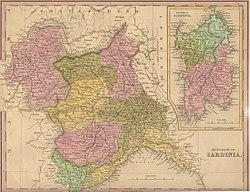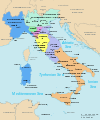You can help expand this article with text translated from the corresponding article in Italian. (June 2023) Click for important translation instructions.
|
| Savoyard stateSabaudia (lat) Stati di Savoia (it) États de Savoie (fr) | |||||||||
|---|---|---|---|---|---|---|---|---|---|
| 1003–1861 | |||||||||
 Flag
Flag
 Coat of arms of Kings of Sardinia
Coat of arms of Kings of Sardinia
| |||||||||
| Motto: FERT | |||||||||
 The Savoyard state in 1839 The Savoyard state in 1839 | |||||||||
| Status | Former plurinational independent state Former constituent territories of the Holy Roman Empire | ||||||||
| Capital | Montmélian (1006–1295) Chambéry (1295–1562) Turin (1562–1792; 1815–1861) Cagliari (1792–1815) | ||||||||
| Common languages | French, Italian, Piedmontese, Arpitan, Occitan, Latin | ||||||||
| Religion | Roman Catholicism | ||||||||
| Government | County, Duchy, and Kingdom | ||||||||
| Count Duke King | |||||||||
| • 1003–1048 | Humbert I White Hands (first) | ||||||||
| • 1849–1861 | Victor Emmanuel II of Sardinia (last) | ||||||||
| Historical era | Medieval era Modern era | ||||||||
| • Humbert I became Count of Savoy | 1003 | ||||||||
| • Kingdom of Sardinia became Kingdom of Italy | 1861 | ||||||||
| |||||||||
| Today part of | France Italy | ||||||||
The Savoyard state comprised the states ruled by the counts and dukes of Savoy from the Middle Ages to the formation of the Kingdom of Italy. Although it was an example of composite monarchy, it is a term applied to the polity by historians and was not in contemporary use. At the end of the 17th century, its population was about 1.4 million.
History
The multi-century history of Savoy included the period before the County of Savoy, then the County of Savoy, the Duchy of Savoy, the period from Savoy to Sicily and Sardinia before Italian unification, and thereafter. From the Middle Ages, the state comprised the Duchy of Savoy, the Principality of Piedmont, the Duchy of Aosta, and the County of Nice, all of which were formally part of the Holy Roman Empire; however, the Savoyards often acted against the Emperor, repeatedly siding with the French during the Franco-Habsburg Wars. From 1708, it included the Duchy of Montferrat, then the Kingdom of Sicily from 1713 until 1720, the Kingdom of Sardinia from 1720, and the Duchy of Genoa from 1815.
The Final Act of the Congress of Vienna of 1815 refers to them as the "States of His Majesty the King of Sardinia". Among contemporaries, "Kingdom of Sardinia" and "Sardinia" were used as common short forms, even though they were confounded with the island. "Piedmont", "Savoy-Piedmont", and "Piedmont-Sardinia" are also sometimes used to emphasise that the economic and political centre of the Savoyard state was the Piedmont since the late Middle Ages. The seat of the rulers was in Turin. Each state had its own institutions and laws.
These territories formed a composite state under the House of Savoy until the Perfect Fusion in 1847. By 1861, this unified state had acquired most of the other states on the Italian peninsula and formed the Kingdom of Italy, while its territories north and west of the Alps (including Savoy proper) became part of France.
Terminology
Scholarship has debated and used several different terms to reference the often disjointed possessions under control of the House of Savoy. Robert Oresko introduced the term "Sabaudian" in 1997.
Territory
-
 Savoy during the Carolingian Empire
Savoy during the Carolingian Empire
-
County of Savoy during the 12th
-
Duchy of Savoy in the 15th
-
 Italian peninsula in 1843
Italian peninsula in 1843
-
 Proper Savoy today
Proper Savoy today
-
 Today's administrative Piedmont in Italy
Today's administrative Piedmont in Italy
Flags
-
 The first counts used the Holy Roman Empire banner as proof of their loyalty to the Emperor
The first counts used the Holy Roman Empire banner as proof of their loyalty to the Emperor
-
 Flag of the County of Savoy and Duchy of Savoy (1023–1783)
Flag of the County of Savoy and Duchy of Savoy (1023–1783)
-
 Flag of the Kingdom of Sardinia used in the late 18th century (1783–1802)
Flag of the Kingdom of Sardinia used in the late 18th century (1783–1802)
-
 Flag of the Kingdom of Sardinia (1832–1848), obtained by merging the flag of Savoy, Sardinia and Genoa
Flag of the Kingdom of Sardinia (1832–1848), obtained by merging the flag of Savoy, Sardinia and Genoa
-
 Flag of Kingdom of Sardinia (1848–1861)
Flag of Kingdom of Sardinia (1848–1861)
References
- Storrs, Christopher (January 13, 2000). War, Diplomacy and the Rise of Savoy, 1690–1720. Cambridge University Press. p. 19. ISBN 978-1-139-42519-3. Archived from the original on August 16, 2023. Retrieved April 29, 2024.
- ^ Vester, Matthew (March 25, 2013). Sabaudian Studies: Political Culture, Dynasty, and Territory (1400–1700). Penn State Press. p. 261. ISBN 978-0-271-09100-6. Archived from the original on August 16, 2023. Retrieved April 29, 2024.
- Geoffrey Symcox. "Victor Amadaeus II: Absolutism in the Savoyard State, 1675-1730." Archived November 6, 2023, at the Wayback Machine Page 245.
- Gregory Hanlon. "The Hero of Italy: Odoardo Farnese, Duke of Parma, his Soldiers, and his Subjects in the Thirty Years' War." Routledge: May 2014. Page 87. Piedmont's population is given at 700,000, and Savoy's at 400,000 in 1630; Aosta and the County of Nice are not listed.
- Sabaudian Studies: Political Culture, Dynasty, and Territory (1400–1700). Vol. 12. Penn State University Press. 2013. doi:10.5325/j.ctv1c9hnc2.7. ISBN 978-1-61248-094-7. JSTOR 10.5325/j.ctv1c9hnc2. Archived from the original on May 10, 2023. Retrieved April 29, 2024.
- Sabaudian Studies: Political Culture, Dynasty, and Territory (1400–1700). Vol. 12. Penn State University Press. 2013. doi:10.5325/j.ctv1c9hnc2.7. ISBN 978-1-61248-094-7. JSTOR 10.5325/j.ctv1c9hnc2. Archived from the original on May 10, 2023. Retrieved April 29, 2024.
| Dukes of Savoy | ||
|---|---|---|
| ||
| States of the House of Savoy | ||
|---|---|---|